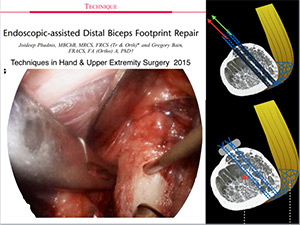Distal Biceps Rupture
The biceps muscle is located in front of your upper arm. It helps in bending your elbow, rotational movements of your forearm and in maintaining stability in the shoulder joint. The biceps muscle has two tendons, one of which attaches it to the bone in the shoulder and the other attaches at the elbow. The biceps tendon at the elbow is called the distal biceps tendon. A tear in this tendon will make it difficult for you to move your arm from the palm down to palm up position. Once the distal biceps tendon is torn, it cannot regrow back to the bone and heal by itself. Permanent weakness during rotatory movements of the forearm may occur, eg such as using a screw driver, if the tendon is not repaired surgically.
Biceps tendon tear can be complete or partial. In partial biceps tendon tear, the tendon does not tear completely but is often painful. Complete tendon tears means it ruptures completely off the radius bone.
Causes
Distal biceps tendon ruptures most often result from a sudden injury or lifting a heavy object. Additional risk factors, such as advancing age, smoking and use of corticosteroid medications, can also result in increased muscle and tendon weakness, which can lead to the tendon rupture.
Signs and symptoms
The most common symptom is a sudden, severe pain in the upper arm or at the elbow. You may feel a "pop" at the elbow when the tendon tears. Other symptoms include swelling, visible bruising, weakness in the elbow, trouble turning your arm from a palm up to a palm down position, and a gap in the front of the elbow, caused by the absence of the tendon. A bulge may also appear in your arm caused by the recoiled, shortened biceps muscle.
Diagnosis
Distal biceps tendon rupture is usually diagnosed based on your symptoms, medical history, and physical examination. During the physical examination, Professor Bain will look for a gap in the tendon by palpating the front part of your elbow. Professor Bain will diagnose a partial tear by asking you to bend your arm and tighten the biceps muscle, and identify weakness and pain if there is a partial tear. Using an MRI scan, Professor Bain can determine whether the tear is partial or complete.
Treatment
Procedure
During distal biceps tendon repair, Professor Bain makes a small incision over the upper forearm, where the biceps muscle attaches to the radius bone. The torn biceps tendon is brought up through the incision. The radius bone is then prepared for tendon reattachment and to promote healing. The sutures are passed through the tendon in a particular interlocking manner so as to ensure a strong tendon repair.

The tendon is secured to the bone with the “anatomic footprint” technique that bring the tendon onto its normal anatomic site. (LINK)


